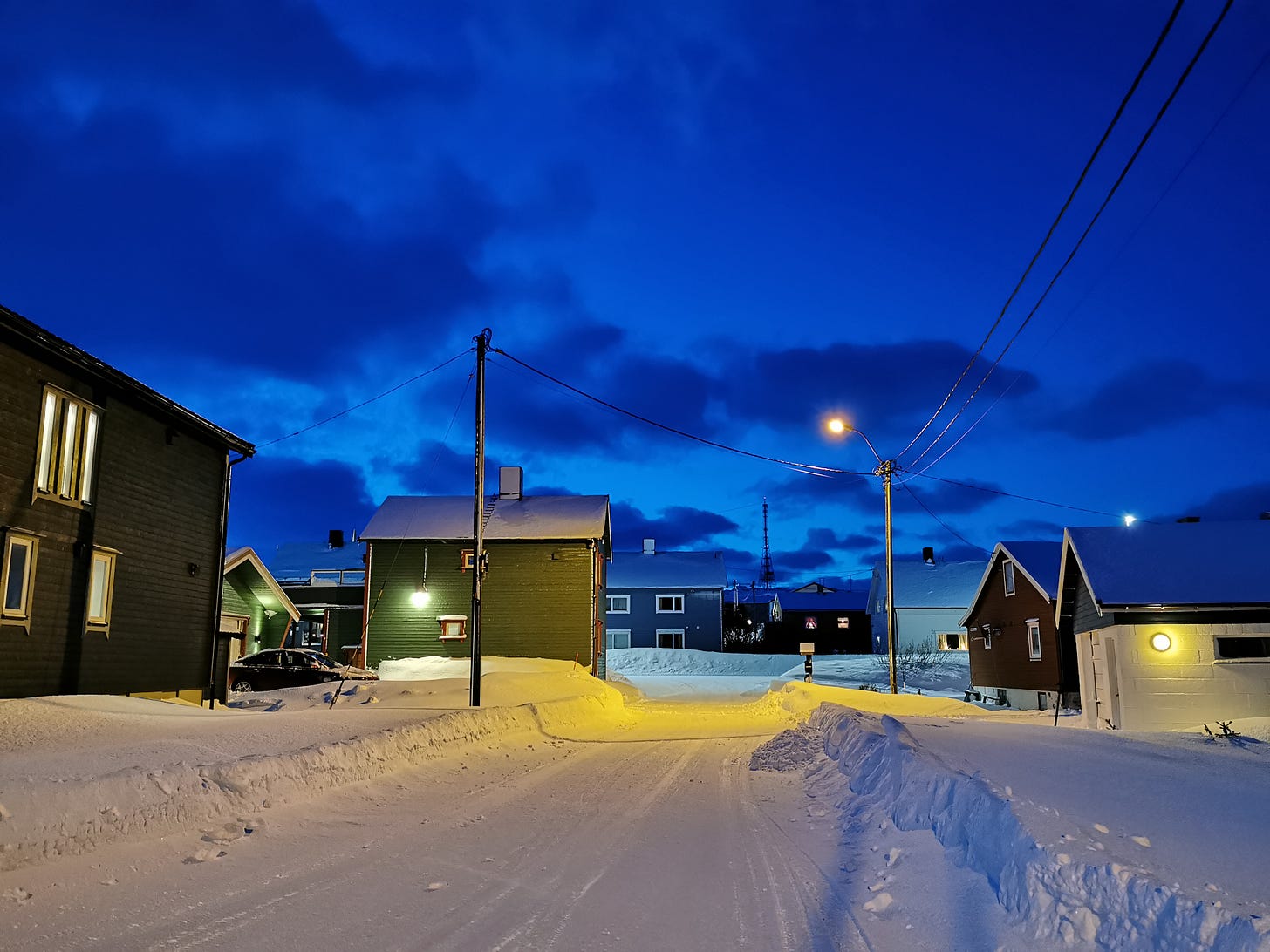The ‘longest Night and shortest Day’: St Lucy’s Day in the Nordics
December 13th was once one of the most dangerous days of the year.
I grew up north of the Arctic Circle, trust me when I tell you, it’s dark there now. Most of the time. Of course, it’s dark in all the Nordic countries, but way up north, the sun won’t rise above the horizon for a long while still. This perpetual night is known as mørketid (the dark time). Alleviated slighly by the blue hours (a sort of blueish light in the sky during parts of the day, see below) and by the magical aurora borealis. However, the dark does create a specific atmosphere. When the winds howl, the world is dark, and clad in snow, is it any wonder that people for hundreds of years believed strange things were afoot?
Svart senker natten seg
I stall og stue
Solen har gått sin vei,
Skyggene truer
Inn i vårt mørke hus
Stiger med tente lys,
Santa Lucia, Santa LuciaDark the night descends
in barn and home
The sun has gone away,
The shadows threaten
Inside our darkened homes
Rising with candles lit,
Santa Lucia, Santa Lucia(first verse of the Norwegian version Luciasangen, based on the Swedish text by Arvid Rosén, rough translation into English by me)
In folk belief, the wintertime was when the veil between worlds was at its thinnest. Only a few hundreds of years ago, belief in Åsgårdsreia (or the Wild Hunt of Odin) remained strong in Norwegian folklore. Christmas, or jul, was a time when sinister creatures moved out there in the cold and dark. Christmas, then, was not wholly a time for merriment, but caution as well. The oldest printed almanack in Norway, published by Tyge Nielssøn in 1644, named the 13th of December as the “longest Night and shortest Day” (“lengste Nat og steckiste Dag”) of the year. And no wonder, the winter solstice also fell on this day in the Julian calendar (the Georgian calendar came into use in 1700 in Denmark and Norway, and in 1753 in Sweden).
The 13th of December was a day of special significance. Not only did it mark the beginning of the Christmas period (juleperioden), but in folk belief it was one of the, if not the, most dangerous night of the year. The night leading up to the 13th, was a night of strange happenings. An upturning of the normal. On this night, barn animals could converse. Lights were lit to keep that which wandered outside in the dark at bay. We know that across Europe there was a belief in wandering spirits at this time of the year. The monk Bede (c. 673-735) wrote that the Anglo-Saxons put out food during Christmas for the spirits. In Norway, people this was a time when the creatures who lived underground (de underjordiske) and the dead (dauinger) came walking. To protect themselves from the ill will of the dead, they set out an extra seat at the table. This place was for the dead, for them to take part in the Christmas meal. People slept in a communal bed, or on the floor, for the dead to use one of the other beds. Of course, this was a way to remember your ancestors at Christmas, but also a way of not crossing the powers of the unknown.
Night to the 13th was the long night of Lussi (Lussi langnatt), and who was she? Although she is probably older than Christianity in Scandinavia, she became known as the ‘die Dunkle’ (the dark), the opposite to St Lucy ‘die Helle’ (the light). But in Norwegian folk belief, she was a female supernatural being (a so-called vette). Some considered her to be of the underground people. On her long night, she rode across the skies, on her lussi journey; her task was to see that people had finished preparations for Christmas. In the Sørlandet region of Norway, the very southern part of the country, people said that she would yell down the chimney “No brewing, no baking, no great fires be had!” (“Inkje bryggja, inkje baka, inkje store eldar hava!”). If you did one of these things, it was said, she would tear down the chimney. In a way, one might, therefore, consider Lussi as representative of the ‘Christmas peace’ (julefreden), which appears to have been as an important concept in the Viking period as it is today.
When day came once more, it was St Lucy’s Day, and with that, light had conquered darkness. The modern-day celebration of St Lucy’s Day in the Nordic countries stems from the early part of the 20th century. It involves a procession (often of children) clad in white robes, holding candles, led by a girl (usually) wearing a crown with candles. I have myself taken part in it when I was in school. Lussi makes no appearance in the procession or song; as it focuses more on light conquering darkness, in the sense of the sun returning and the promise of a new year. They usually sing a special song and hand out buns made with saffron and raisins. The buns are known as lussekatter (literally ‘Lucy cats’, or, should that be ‘Lussi cats’?). Perhaps the beliefs of old linger with us still.
This post is based on two advent calendar posts I wrote in Norwegian a couple of years ago. In large part, it’s based on Kristofer Visted’s book Jul i gamle dager (Oslo: Scandinavian Academic Press, 2016).




